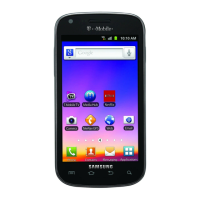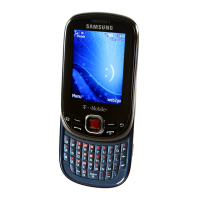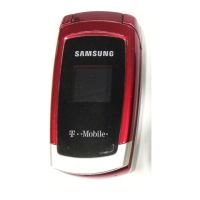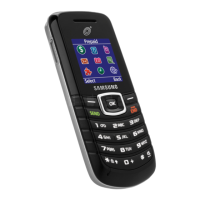Do you have a question about the Samsung SGH-T500 and is the answer not in the manual?
Guidelines for safe driving, refuelling, aircraft, hospital use, and general regulations.
List of items included in the phone package.
Description of phone's physical layout, display areas, backlight, and external display.
Step-by-step guide for inserting SIM and battery, with safety notes.
Instructions for charging the battery and powering the phone on/off.
How to use the supplied ear-microphone for calls and its button functions.
Steps for dialling, ending calls, and redialling numbers.
How to answer/reject calls and adjust volume, including Any-key Answer.
Managing missed calls and accessing functions like microphone mute during calls.
Placing calls on hold, answering second calls, and managing multiparty calls.
Overview of the phonebook and steps to store contacts with names.
Accessing phonebook options like editing, erasing, copying, and speed dialling.
Detailed steps for finding and calling numbers from the phonebook.
How to switch between T9, ABC, Number, and Symbolic text input modes.
Features for punctuation, case change, scrolling, and text deletion across modes.
How to navigate through the phone's menus and sub-menus using soft keys.
Overview of the phone's menu hierarchy and available options.
Viewing and managing call logs, including time and cost information.
Accessing voice mail and reading text messages.
Composing, sending text and picture messages, and managing preset messages.
Using voice features for dialling, commands, memos, and answering calls.
Customizing ring tones, including composing melodies and selecting alert types.
Adjusting ring volume and selecting tones for keypad, messages, and power states.
Setting greeting messages, language, any-key answer, and backlight.
Managing network services like call diverting, barring, waiting, and network selection.
Securing the phone with PIN, lock, passwords, SIM lock, and FDN mode.
Customizing display (wallpaper, brightness) and configuring browser settings.
Managing schedules, events, and birthdays with calendar and scheduler functions.
Setting alarms, using the calculator, and managing tasks in the To Do List.
Tools for checking global times, converting units, timing events, and measuring durations.
Playing games and checking body condition (bio rhythm, calories).
Using the phone as a web browser, accessing homepages, and managing bookmarks.
Troubleshooting common phone issues like no service, battery problems, and call quality.
Information on safety, access codes, battery care, road safety, and device interference.
Definitions of technical terms, services, and abbreviations used in the manual.
Guidelines for safe driving, refuelling, aircraft, hospital use, and general regulations.
List of items included in the phone package.
Description of phone's physical layout, display areas, backlight, and external display.
Step-by-step guide for inserting SIM and battery, with safety notes.
Instructions for charging the battery and powering the phone on/off.
How to use the supplied ear-microphone for calls and its button functions.
Steps for dialling, ending calls, and redialling numbers.
How to answer/reject calls and adjust volume, including Any-key Answer.
Managing missed calls and accessing functions like microphone mute during calls.
Placing calls on hold, answering second calls, and managing multiparty calls.
Overview of the phonebook and steps to store contacts with names.
Accessing phonebook options like editing, erasing, copying, and speed dialling.
Detailed steps for finding and calling numbers from the phonebook.
How to switch between T9, ABC, Number, and Symbolic text input modes.
Features for punctuation, case change, scrolling, and text deletion across modes.
How to navigate through the phone's menus and sub-menus using soft keys.
Overview of the phone's menu hierarchy and available options.
Viewing and managing call logs, including time and cost information.
Accessing voice mail and reading text messages.
Composing, sending text and picture messages, and managing preset messages.
Using voice features for dialling, commands, memos, and answering calls.
Customizing ring tones, including composing melodies and selecting alert types.
Adjusting ring volume and selecting tones for keypad, messages, and power states.
Setting greeting messages, language, any-key answer, and backlight.
Managing network services like call diverting, barring, waiting, and network selection.
Securing the phone with PIN, lock, passwords, SIM lock, and FDN mode.
Customizing display (wallpaper, brightness) and configuring browser settings.
Managing schedules, events, and birthdays with calendar and scheduler functions.
Setting alarms, using the calculator, and managing tasks in the To Do List.
Tools for checking global times, converting units, timing events, and measuring durations.
Playing games and checking body condition (bio rhythm, calories).
Using the phone as a web browser, accessing homepages, and managing bookmarks.
Troubleshooting common phone issues like no service, battery problems, and call quality.
Information on safety, access codes, battery care, road safety, and device interference.
Definitions of technical terms, services, and abbreviations used in the manual.
| Model | SGH-T500 |
|---|---|
| Network Technology | GSM |
| 2G bands | GSM 900 / 1800 / 1900 |
| GPRS | Class 8 |
| EDGE | No |
| Status | Discontinued |
| SIM | Mini-SIM |
| Ringtones | Monophonic |
| Vibration | Yes |
| Call records | 10 dialed, 10 received, 10 missed calls |
| Card slot | No |
| Camera | No |
| Loudspeaker | No |
| 3.5mm jack | No |
| Bluetooth | No |
| Radio | No |
| USB | No |
| Messaging | SMS |
| Browser | WAP 1.2.1 |
| Clock | Yes |
| Alarm | Yes |
| Games | Yes |
| Java | No |
| Predictive text input | Yes |
| Currency converter | Yes |
| Organizer | Yes |
| Stand-by | Up to 150 h |
| Talk time | Up to 3 h |
| Colors | Silver |
| Battery | Removable Li-Ion |











